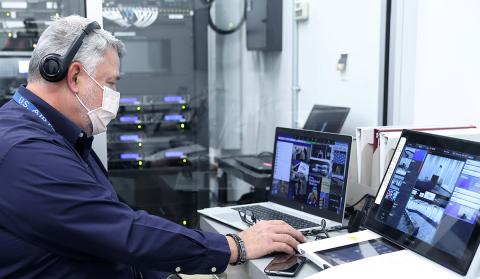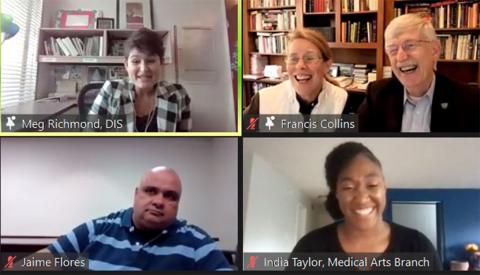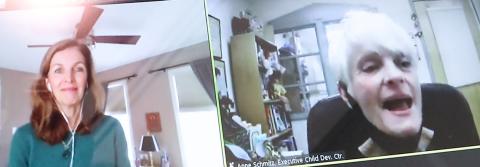‘You’re the Magicians’
Collins Thanks Program, Services Staff for Extraordinary Work

Photo: Chia-Chi Charlie Chang
Countless behind-the-scenes efforts happen every day to keep NIH churning at maximum capacity. Even with all the challenges throughout the pandemic, a mind-boggling array of activities continued uninterrupted to make sure staff and visitors had needed resources—from producing safety signage to managing mail; providing daycare to shuttling patients; engineering videocasts to processing foreign scientists’ visas—all to keep NIH’s mission moving.
On Nov. 15, then-NIH director Dr. Francis Collins thanked staff from ORS’s Program and Employee Services Cluster in one of the final stops of his gratitude tour.
“You are all unsung heroes,” Collins said to the more than 100 ORS employees on the Zoom and others on site, spaced along a conference table and in the Bldg. 10 cafeteria. “You provide services to NIH employees, contractors, patients and visitors that are really essential for our day-to-day work, and also help people with their work-life balance, which has been challenged a bit here these past 2 years.”
Acknowledging all of this work that occurred under difficult circumstances and praising these employees for rising to the challenge, he said, “Maybe some people think it’s just magic. Well, you’re the magicians.
“Maybe you didn’t think anybody was noticing, but oh boy have we been noticing.” And the statistics are impressive.
- Since the start of the pandemic, shuttles have transported more than 145,000 patients and visitors
- Over the last 16 months, more than 8,000 patients used the Clinical Center’s valet parking
- More than 200 fitness classes became virtual and had more than 15,000 views
From January to October 2021:
- Staff processed more than 1.4 million pieces of incoming mail and dispatched more than 2.9 million pieces of outgoing mail
- More than 600,000 hours of childcare were provided at the 3 NIH-sponsored childcare centers
- Medical Arts produced more than 3,000 Covid-related posters, flyers, floor signs and digital graphics; designed hundreds of materials and artwork—including murals for campus and the NIH-Walter Reed tunnel; won 6 competitive scientific journal cover illustrations

When the pandemic first hit, there was an immediate need for posters and other visuals to display safety measures and guide patients, visitors and staff. Graphic designer India Taylor of the Medical Arts Branch led the effort to produce and update Covid safety signs throughout NIH buildings, which often required quick turnaround. In those early days, when most NIH’ers transitioned to full-time telework, Taylor said her production team came to the office.
“Just a few signs were provided to accommodate what we thought would be 3 weeks of working from home,” Taylor recounted. “However, as things morphed into a much larger initiative, we went back daily to support messaging efforts for needs such as campus entry, building entry, car-line testing and social distancing.”
Meanwhile, ORS played a critical role working with the Centers for Information Technology to support broadcasts of virtual and live meetings, conference and town halls.The pandemic has more than tripled the Events Management Branch’s multimedia workload.
“It’s been nonstop for us,” said ORS broadcast engineer Mike Burnham. His group broadcast 720 virtual events in 2020 and more than 900 in 2021, while managing 1,100 live events—from NIAID director Dr. Anthony Fauci’s studio sessions to frontline workers receiving their first Moderna vaccines in Masur Auditorium.

One of the busiest days, Burnham recalled, was preparing for former HHS Secretary Alex Azar’s visit, which involved numerous last-minute script changes. “With the help of [our audio-visual] engineers, we got the script floated, lit the studio with all the flags in the background. It was flawless,” he said. “We do all of this so the NIH stays on top of its game.”
It was also no small feat for staff from the Division of Mail Management Services to handle all the mail during the pandemic. These NIH’ers worked on site every day to sort, process and deliver—or in many cases store—incoming mail and meter and dispatch outgoing mail.
“The epidemic brought us new physical and safety challenges to our mail center,” said Jaime Flores, the division’s contract project manager. “We created split shifts for field personnel to ensure social distancing and utilized PPE in order to process mail correctly, but safely.”

Photo: Chia-Chi Charlie Chang
The Division of International Services (DIS) also had to juggle ongoing challenges. On Mar. 16, 2020, “We had to send out messages to our incoming foreign national trainees letting them know the State Department was closing consulates and embassies for non-emergency appointments,” said Meg Richmond, a DIS immigration policy analyst.
Since then, she said, “we have responded to over 16 executive orders related to immigration and international travel to find ways to get the world’s best and brightest scientists to NIH.” This included welcoming nearly 1,000 new visiting scientists to NIH and assisting more than 200 current trainees in obtaining extensions.
Parents found some relief a few months into the pandemic, when many childcare centers began resuming operations—including NIH’s three childcare centers, under the Division of Amenities and Transportation Services’ Child and Family Program.
“We reopened our center in late June 2020 to a flood of very grateful visiting fellows, trainees and NIH employees,” said Anne Schmitz, director of NIH’s largest Child Development Center on Executive Blvd. Parents could count on quality care for their toddlers while trying to conduct research.

During the pandemic, the food service program found innovative solutions for providing food options for the NIH community, such as introducing Eatify, an app that enables meal pre-orders by phone.
Still other staff helped ensure accessibility for deaf and hard-of-hearing employees. Linda Kiefer discussed managing the largest interpreting services program in the federal government.
“Pre-pandemic annual usage increases were about 2 percent. But usage spiked 18 percent last year, when most of us were working from home,” she said. “The surge was overwhelming.”
Early on, her team procured clear masks for sign language interpreters and introduced a new virtual service enabling deaf and hard-of-hearing employees to telework with their interpreters.
Several presenters took a moment to thank Collins—who was within weeks of stepping down as NIH director. They praised his compassion, humor, honesty and leadership.
“Dr. Collins, we certainly are going to miss your strong and steady leadership,” said Kiefer. “But what I will miss most are the heartfelt songs of hope and gratitude that you sang to reassure all of us that the work we do matters.”
